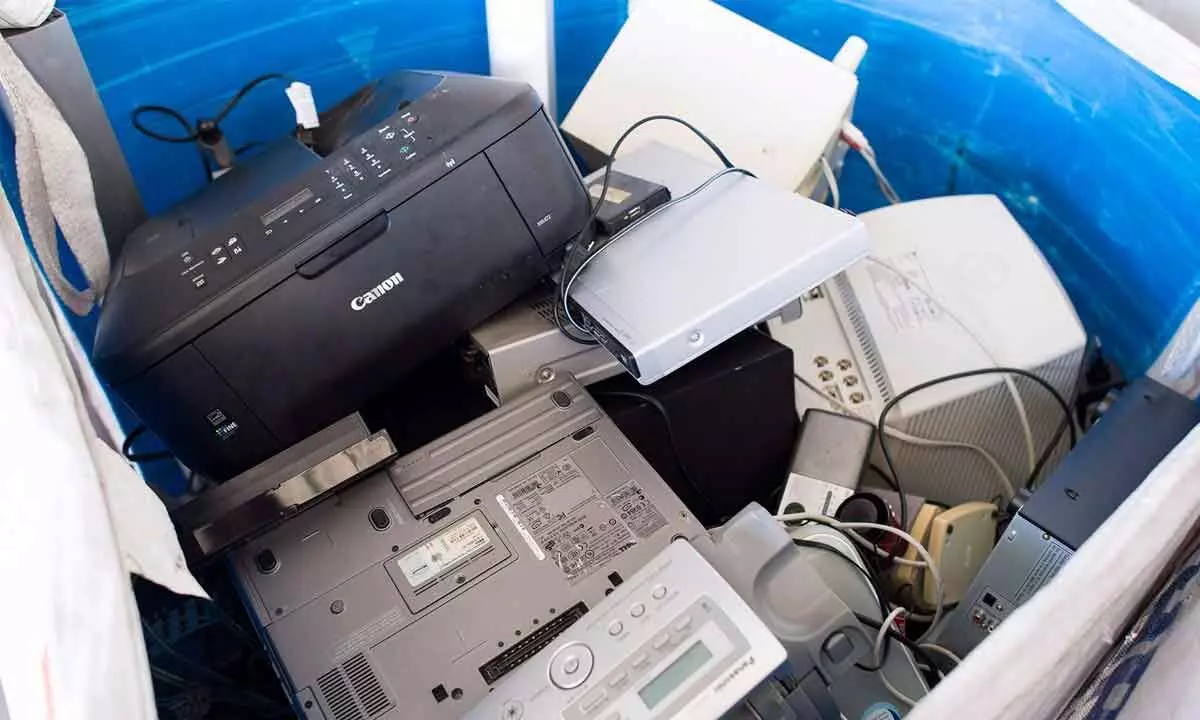How to manage our growing pile of e-waste

Canada’s e-waste is increasing, yet there is little understanding of the effect it is having on recycling programs or greenhouse gas emissions. Recycling systems were never made to manage the quantities and complexity of materials being discarded
Electronics have become an essential part of daily living that come with an often hidden and perilous price tag: an exploding amount of garbage. A University of Waterloo study suggests Canada produced almost a million tons of electronic waste (e-waste) in 2020. The amount of per capita e-waste Canadians produce has almost tripled from 8.3 kilograms in 2000 to 25.3 in 2020.
Although Canada is facing multiple challenges in managing its e-waste, there are laws in place to deal with this issue. At the federal level, Environment and Climate Change Canada is responsible for policies related to disposal, handling, and shipment of toxic wastes.
Specifically, regulations governing the export and import of hazardous wastes have been adopted under the Canadian Environmental Protection Act (CEPA). Recently, CEPA was updated with the adoption of Bill S-5, the Strengthening Environmental Protection for a Healthier Canada Act, where the right to a healthy environment will be recognized for the first time in federal law.
At the provincial, municipal and territorial levels, governments are responsible for domestic recycling and disposal. Officials devise e-waste handling rules that require “extended producer responsibility” (EPR) for specific electronic and electrical devices.
Apart from Nunavut, all provinces and territories in Canada have implemented regulated EPR programs for managing their e-waste. In Ontario, electrical and electronic equipment regulations fall under the Resource Recovery and Circular Economy Act updated in 2020.
Progress in managing e-waste at all levels of government has been slow. Informing Canadians on how to lower their e-waste footprint and co-ordinating programs that deal with this type of waste both globally and domestically may help.
Improve public engagement and waste audits Public engagement is necessary for a sustainable e-waste management program because these programs rely on the participation of Canadians across the country.
Education and outreach efforts are required with solutions that are inclusive and convenient for everyone.
This means gathering information (which is often left out by the waste management sector) from Canadian municipalities. Unfortunately, data for e-waste management in Canada is quite limited and there is no data on collection and recycling rates.
There is no information available regarding greenhouse gas emissions released from collection and processing activities, the costs of resource recovery measures or for managing different types of e-waste. And what happens once e-waste is disposed of is not being tracked.
Although provinces and localities in Canada produce annual reports that flesh out statistics from recycling programs, these numbers are only approximations and not actual values of the current state of e-waste management across Canada.
For example, waste audits, like the one done by the University of Toronto, surveyed 16 of the downtown buildings in 2022. However, waste audits are simply that – a study of waste. They examine different materials found in e-waste and analyze how much of it is produced by a company or household during a specific time.
Waste audits may be either recommended or compulsory depending on different regulations. For example, businesses in Ontario are required to conduct a waste audit and create a waste reduction work plan.
More meaningful waste audits would ensure better representation. Audits conducted by “producer responsibility organizations” (PROs) should devise improved methods for monitoring the performance of their EPR programs and tracking the ways in which their progress can be transparently communicated.
Canada is also too fixated on recycling materials. Many Canadians have come to believe that recycling is the silver-bullet solution to all the waste problems. However, recycling systems were never made to manage the quantities and complexity of materials being discarded.
Focus needs to be shifted toward motivating behavioural changes among consumers that involve reducing, reusing and repairing. A national communications strategy should emphasize empowering Canadians to cut down their waste and consumption habits. Canadians may make ethical and impactful choices in support of e-waste prevention objectives if they are made more aware of devices’ ecological footprint.
Foster greater co-operation
There is a fragmented system in place between provinces, which works against instituting comprehensive e-waste programs. Policymakers often disagree about what actions need to be taken. Often, regulations are not properly communicated.
Any e-waste management system’s success is dependant on how well-established it is. Since there has been no integration of e-waste systems across provinces, programs are not well established at a national level.
While greater co-ordination could be beneficial, harmonisation would be better. Current laws mean that each province has a different program in place covering differing ranges of products. What works in Saskatchewan may not work in Ontario. Manufacturers only adhere to the requirements of their region.
Creating consistent objectives and performance measures nationally with clear definitions, goals and targets would result in an improvement in e-waste reduction and allow for greater transparency in the process.
Co-operation is not only needed domestically but also globally. Canada needs to adopt these tools to foster knowledge and innovation. It is imperative for Canadian institutions to work together with companies, particularly the private sector, to make research visible to the public as well as to facilitate informed decision-making.
E-waste management will continue to evolve in an era threatened by climate change. As the amount of e-waste continues to rapidly increase, sustainable management must gravitate toward a centralized model that is more focused on data transparency and public education.
(The writer is a graduate student at Toronto Metropolitan University studying environmental applied science and management, with research interests in sustainable e-waste management and the circular economy)














